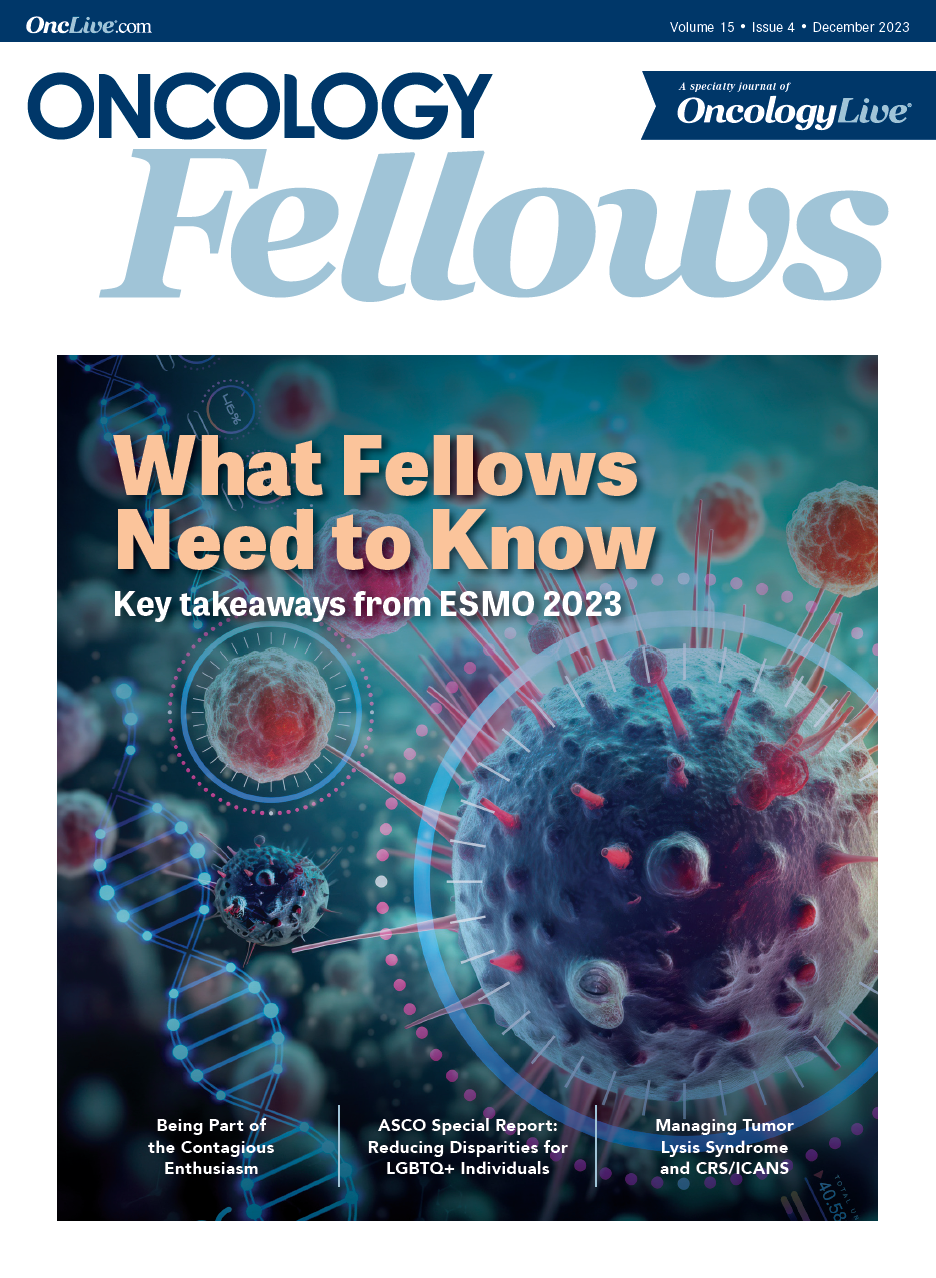Publication
Article
Managing TLS and CRS/ICANS: Through the Lens of a First-Year Hematology/Oncology Fellow
Author(s):
Key Takeaways
- TLS requires prophylactic management to prevent complications like acute kidney injury, cardiac arrhythmia, and death. Treatment includes isotonic intravenous fluids and hypouricemic agents.
- Allopurinol and rasburicase are commonly used hypouricemic agents in TLS management. Allopurinol prevents new uric acid formation, while rasburicase breaks down existing uric acid.
Tumor lysis syndrome is an oncologic emergency that every clinician will likely encounter at one time or another, and managing it requires careful consideration of a number of factors.
Nishanth Thalambedu, MD

Tumor lysis syndrome is an oncologic emergency that every clinician will likely encounter at one time or another, and managing it requires careful consideration of a number of factors. Using the following case studies, I will highlight some of the unique aspects of TLS management.
Case 1
A 32-year-old Hispanic woman presented to the emergency department with 6 weeks’ history of worsening lower back and pelvic pain associated with weight loss, fevers, and night sweats. Initial imaging showed diffuse abdominal-pelvic lymphadenopathy concerning a hematological malignancy. On the patient’s admission, abnormal laboratory results included potassium levels of 5.8 mmol/L, uric acid levels of 9.6 mg/dL, lactate dehydrogenase (LDH) of 1280 U/L, and a creatinine level of 2.3 mg/dL. Complete blood counts (CBCs) revealed a low hemoglobin level of 7.6 g/dL and platelet count of 76000/uL. Further workup revealed highgrade lymphoma indicating Burkitt lymphoma. She received a diagnosis of tumor lysis syndrome (TLS) from lymphoma and was appropriately treated.
TLS is 1 of the most common oncologic emergencies encountered by every resident, fellow, and/or faculty member caring for patients with cancer, and is broadly classified into laboratory and clinical TLS.
Laboratory TLS is defined as 2 or more abnormal serum values (Table 1), present within 3 days before or 7 days after instituting chemotherapy. Clinical TLS is defined as laboratory TLS plus one or more of the following clinical findings: increased serum creatinine concentration (≥ 1.5 times the upper limit of normal), cardiac arrhythmia/sudden death, or a seizure that was not directly or probably attributable to a therapeutic agent.1
The necessity to prophylactically manage TLS stems from the significant complications including acute kidney injury (AKI), cardiac arrhythmia, and death when TLS is untreated or the treatment is delayed. The main preventive treatment options include isotonic intravenous fluids (IVFs) and the use of hypouricemic agents such as allopurinol and rasburicase.
The recommended rate of IVF is 2 to 3L/m2 daily to maintain a urine output of 80 to 100 mL/m2 per hour. Achieving high urine output is thought to improve renal perfusion and minimize the likelihood of uric acid or calcium phosphate precipitation in the tubules. However, close monitoring for fluid overload should be performed, and diuretics can be used if required.
Allopurinol is a xanthine oxidase inhibitor that prevents the formation of new uric acid, and ideally should be started 2 to 3 days prior to initiation of chemotherapy when possible. The recommended dose of allopurinol is 100 mg/m2 every 8 hours, with a maximum of 800 mg daily, and the dose is reduced by 50% in the setting of AKI to prevent accumulation of allopurinol.2
If TLS does not occur, allopurinol can be discontinued within 10 to 14 days of chemotherapy initiation. Febuxostat is another orally available hypouricemic drug that selectively inhibits xanthine oxidase and does not need renal adjustments. It can be used when allopurinol or rasburicase is contraindicated.3
In contrast, rasburicase is a recombinant urate oxidase that causes the breakdown of uric acid and rapidly reduces its levels in the serum and is ideal when patients need urgent initiation of chemotherapy and already have elevated uric acid levels. The FDA-approved dosage for rasburicase is 0.2 mg/kg daily for 5 days; however, in practice, single flat doses are commonly used.
Meta-analyses of studies regarding single-dose rasburicase have determined that a single 3-mg dose is often sufficient to lower and maintain uric acid levels if baseline uric acid is less than 12 mg/dL, and a single 6-mg dose is often sufficient if the uric acid is at least 12 mg/dL.4
Our institutional audit of rasburicase usage and outcomes was consistent with these findings. Additional doses can be used if hyperuricemia recurs. The treatment of patients with established TLS is along the same lines as that for preventing TLS along with prompt monitoring of electrolytes and correcting them appropriately. In the era of rasburicase, renal replacement therapy is reserved for those with fluid overload, oliguric or anuric acute renal failure, and persistent electrolyte abnormalities.
Case 2
A 67-year-old White man was admitted to the hospital for chimeric antigen receptor (CAR) T-cell infusion for his primary refractory diffuse large B-cell lymphoma. On day 2 of the post CAR T-cell infusion, he developed high-grade fevers. He received antipyretics and was started on prophylactic antibiotics after an infectious workup was performed. His fevers continued to worsen, and he received tocilizumab (Actemra) for suspected grade 1 cytokine release syndrome (CRS). His symptoms were better after 2 doses of tocilizumab, and he was discharged on day 7 in a stable condition.
CRS and immune effector cell-associated neurotoxicity syndrome (ICANS) are other common hematological emergencies associated with CAR-T cell therapy and T-cell engaging antibodies. CRS is an acute systemic inflammatory condition associated with fever, hemodynamic instability, and multiorgan dysfunction.5 Laboratory abnormalities include elevated inflammatory markers, C-reactive protein, and ferritin. However, these are nonspecific and can be elevated in other inflammatory and infectious states. Substantial elevation of serum IL-6 levels is a more specific marker of CRS, but the availability is limited to specialized laboratories.
CRS usually occurs with a median onset of 2 to 3 days post CAR T-cell therapy and resolves within 1 week. ICANS has a delayed median onset of 5 days and can last for up to 2 weeks. It can occur concurrently with CRS or as a different syndrome by itself. CRS usually starts with fever (≥ 38.0 °C) and gradually progresses to hypotension. Severe CRS manifests with hemodynamic collapse and increased vascular permeability, leading to peripheral and/or pulmonary edema, renal failure, cardiac dysfunction, and multiorgan system failure. ICANS, on the other hand, can present with mild alterations in mental status to severe neurological dysfunction.
Grading of CRS and ICANS is crucial because it determines the management of the conditions. Criteria are formulated by the American Society for Transplantation and Cellular Therapy (ASTCT). For a quick calculation, we recommend utilizing the CRS and ICANS calculator in the ASTCT mobile application, which postulates the results quickly. It is important to keep in mind that the symptoms of CRS/ICANS must not be attributable to any other cause, especially infection and sepsis.
Initial management of CRS/ICANS includes symptomatic treatment with antipyretics, IV hydration, prophylactic broad-spectrum antibiotics, and antiepileptics, and performing appropriate investigations to rule out CRS/ICANS mimics, especially sepsis and other central nervous system pathologies. Tocilizumab, an IL-6 receptor antagonist, is used for grade 1 or higher CRS and persistent or refractory grade 1 CRS. It has no effect in ICANS because the drug does not pass through the blood-brain barrier.6 It is given intravenously over 1 hour at an 8-mg/kg dose and can be given every 8 hours up to 3 doses, with a total dose not exceeding 800 mg.
Glucocorticoids are the mainstay of treatment for patients with ICANS, but are also considered in persistent grade 1 and rapidly progressive CRS, depending on the type of CAR T-cell product. IV dexamethasone at 10 mg every 6 to 12 hours is the typical glucocorticoid used, and doses can be increased to 20 mg every 6 to 12 hours for rapidly progressive CRS/ICANS. Steroids are continued until the symptoms resolve to grade 1 or less and taper over 3 days. In severe cases of CRS/ICANS, patients who fail to improve after multiple doses of both tocilizumab and steroids may be given methylprednisolone at 2 mg/kg up to 1 g daily for 3 days as a last resort, accepting the fact that this may ablate the CAR T cells. Other agents tried in severe cases include siltuximab (Sylvant), anakinra (Kineret), and etanercept (Enbrel).7
References
- Coiffier B, Altman A, Pui CH, Younes A, Cairo MS. Guidelines for the management of pediatric and adult tumor lysis syndrome: an evidence-based review. J Clin Oncol. 2008;26(16):2767-2778. doi:10.1200/jco.2007.15.0177
- Howard SC, Trifilio S, Gregory TK, Baxter N, McBride A. Tumor lysis syndrome in the era of novel and targeted agents in patients with hematologic malignancies: a systematic review. Ann Hematol. 2016;95(4):563-573. doi:10.1007/s00277-015-2585-7
- Lopez-Olivo MA, Pratt G, Palla SL, Salahudeen A. Rasburicase in tumor lysis syndrome of the adult: a systematic review and meta-analysis. Am J Kidney Dis. 2013;62(3):481-492. doi:10.1053/j. ajkd.2013.02.378
- Yu X, Liu L, Nie X, et al. The optimal single-dose regimen of rasburicase for management of tumour lysis syndrome in children and adults: a systematic review and meta-analysis. J Clin Pharm Ther. 2017;42(1):18-26. doi:10.1111/jcpt.12479
- Frey N, Porter D. Cytokine release syndrome with chimeric antigen receptor T cell therapy. Biol Blood Marrow Transplant. 2019;25(4):e123-e127. doi:10.1016/j.bbmt.2018.12.756
- Neelapu SS, Tummala S, Kebriaei P, et al. Chimeric antigen receptor T-cell therapy—assessment and management of toxicities. Nat Rev Clin Oncol. 2018;15(1):47-62. doi:10.1038/nrclinonc.2017.148
- Brudno JN, Kochenderfer JN. Toxicities of chimeric antigen receptor T cells: recognition and management. Blood. 2016;127(26):3321-3330. doi:10.1182/blood-2016-04-703751










